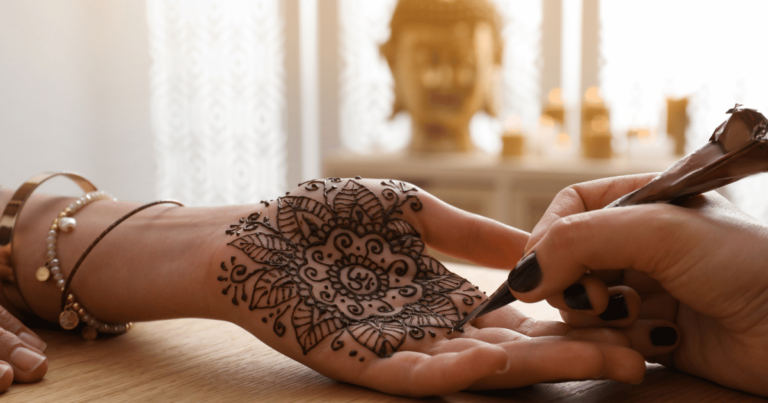Mehndi, or henna art, has long been an essential part of cultural celebrations, bridal traditions, and festivities. Whether you’re a bride looking to perfect your wedding day look, a fashion enthusiast following the latest trends, or a cultural enthusiast excited to express artistry, simple front-hand mehndi designs are timeless, elegant, and versatile options worth exploring.
Table of Contents
What You’ll Learn in This Blog:
- Popular styles of front-hand mehndi designs
- A guide to creating simple designs step-by-step
- Special tips for making your mehndi stain dark and long-lasting
- Answers to frequently asked questions about mehndi art
Types of Front Hand Mehndi Designs
From minimalist patterns to intricate artwork, mehndi designs vary in style and complexity. Here’s a look at some popular front-hand styles you can try:
| Design Style | Description | Ideal For |
| Floral Mehndi | Features flower patterns for natural, elegant vibes | Bridesmaids, casual celebrations |
| Arabic Mehndi | Includes flowing, asymmetrical patterns with fine detailing | Evening events, festive gatherings |
| Mandala Mehndi | Focuses on circular, symmetrical designs at the center of your hand | Weddings, formal occasions |
| Minimalist Mehndi | Simple, clean patterns or single motifs for a modern, chic look | Everyday wear, minimalistic style |
| Peacock Mehndi | Incorporates peacock motifs, signifying grace and beauty | Traditional cultural ceremonies |
| Jewelry Style Mehndi | Mimics the look of jewelry with chain-like and bangle-inspired designs | Brides, engagement ceremonies |
Next, we’ll guide you step-by-step on how to create a simple yet stunning design.
How to Create a Simple Front Hand Mehndi Design
Want to try front hand mehndi art but don’t know where to start? Follow these easy steps for flawless designs:
Step 1: Gather Your Materials
Ensure you have the essentials:
- A high-quality mehndi cone
- Tissue paper to wipe mistakes
- A tracing pencil (optional for beginners)
Step 2: Pick a Design
Choose a style that matches the occasion. Start with floral or minimalist designs if you’re a beginner—they’re simple yet remarkably elegant.
Step 3: Start with Basic Shapes
Begin by tracing simple shapes like circles or lines on your palm and fingers. Build your pattern outward to ensure symmetry and balance.
Step 4: Add Detailing
Once the basic pattern is complete, enhance it with intricate details like dots, swirls, or shading for added depth.
Step 5: Outline the Design
To make the design pop, gently outline certain elements of the pattern. This adds definition and makes your design more striking.
Quick Tip for Beginners:
If you’re nervous about freehanding, practice using a stencil or pre-drawn pattern.
Making Your Mehndi Stain Darker and Long-Lasting
A deep, rich mehndi stain is often a symbol of good luck and beauty. Here are some tips to make your mehndi stand out:
- Leave It On Longer: Aim to keep the mehndi on your skin for at least 6–8 hours.
- Apply Lemon and Sugar Mixture: Dab a mixture of lemon juice and sugar over the dried mehndi. This acts as a sealant to enhance the color.
- Avoid Water: Keep your hands away from water for at least 12 hours after removing the dried mehndi paste. This prevents the stain from fading prematurely.
- Use Clove Smoke: Pass your hands over cloves heated on a pan. The smoke helps darken the stain naturally.
Frequently Asked Questions (FAQs)
Q1. How long does mehndi take to dry?
It typically takes 30–45 minutes for mehndi to dry on your skin. For a darker stain, it’s recommended to keep the paste on for 6–8 hours before scraping it off.
Q2. How can I make a mehndi design last longer?
Ensure the mehndi stays dry for at least 12 hours after applying. Avoid scrubbing your hands and use natural oils like coconut or olive oil to moisturize instead of water-based lotions.
Q3. Are there any side effects of using mehndi?
High-quality natural mehndi is generally safe. However, avoid chemically dyed cones (e.g., “black henna”), as they can cause allergic reactions or irritation.
Q4. Can I try mehndi if I’m a beginner?
Absolutely! Start with simple designs like dots, lines, and basic floral patterns. Many online tutorials can also help you develop your skills.
Q5. How long does a mehndi stain last?
A well-applied mehndi design can last anywhere from 7–14 days. The longevity depends on skin type, aftercare, and your daily activities.
Final Thoughts
Simple front-hand mehndi designs beautifully blend tradition, art, and creativity. Whether you’re a bride-to-be, a cultural enthusiast, or someone experimenting with mehndi for fun, these easy techniques will elevate your style effortlessly.
Looking to perfect your skills? Bookmark this blog for your next mehndi session and share it with fellow enthusiasts. Have a special occasion coming up? Try one of these stunning designs and make a statement!

